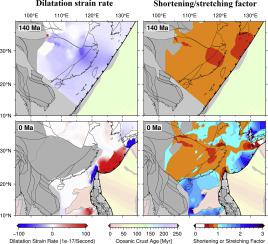当前位置:
X-MOL 学术
›
Gondwana Res.
›
论文详情
Our official English website, www.x-mol.net, welcomes your feedback! (Note: you will need to create a separate account there.)
A deforming plate tectonic model of the South China Block since the Jurassic
Gondwana Research ( IF 6.1 ) Pub Date : 2020-12-01 , DOI: 10.1016/j.gr.2020.11.010 Xianzhi Cao , Sabin Zahirovic , Sanzhong Li , Yanhui Suo , Pengcheng Wang , Jinping Liu , R. Dietmar Müller
Gondwana Research ( IF 6.1 ) Pub Date : 2020-12-01 , DOI: 10.1016/j.gr.2020.11.010 Xianzhi Cao , Sabin Zahirovic , Sanzhong Li , Yanhui Suo , Pengcheng Wang , Jinping Liu , R. Dietmar Müller

|
Abstract The South China Block has experienced multiple phases of tectonic deformation since the Middle Jurassic. Understanding this deformation history helps reveal the driving mechanisms responsible and sheds light on the associated magmatism and mineralization. Here, we construct deformable plate tectonic reconstructions for the South China Block from 170 Ma to the present using GPlates. The deformation starts with a NW–SE-oriented shortening phase from 170 to 136 Ma. Subsequently, South China experienced two episodes of extension in the Cretaceous, during 136–118 Ma and 100–80 Ma, respectively. The Cenozoic extension occurred mostly along the southeast continental margin, including the East China Sea Shelf Basin, and rift basins in the northern South China Sea margin and the Taiwan margin segment. The rifting was initiated nearly simultaneously along the continental margin at ~65 Ma and ceased at ~34–30 Ma. The northern portion of the Okinawa Trough started rifting at 15 Ma, while the southern portion rifted in the last few million years. The Luzon Volcanic Arc’ thrusting onto the southeasternmost South China Block since 6.5 Ma caused the still-active Taiwan Orogeny. The predicted accumulated deformation at present-day is characterized by overall shortening onshore with contraction factors mostly between 0.8 and 1 and extension offshore with stretching factors generally between 1 and 2. The Central China Orogen and Taiwan Orogen experienced more intense shortening relative to the interior South China by factors down to 0.6. The Okinawa Trough experienced intense stretching by factors up to 2.5 in its central part. The intraplate deformation in the South China Block is closely related to the subduction of the Izanagi and Pacific plates. The Jurassic and earliest Cretaceous shortening was likely induced by trench advance, and the extension during the Cretaceous and the Cenozoic was mostly driven by subduction retreat.
更新日期:2020-12-01


























 京公网安备 11010802027423号
京公网安备 11010802027423号